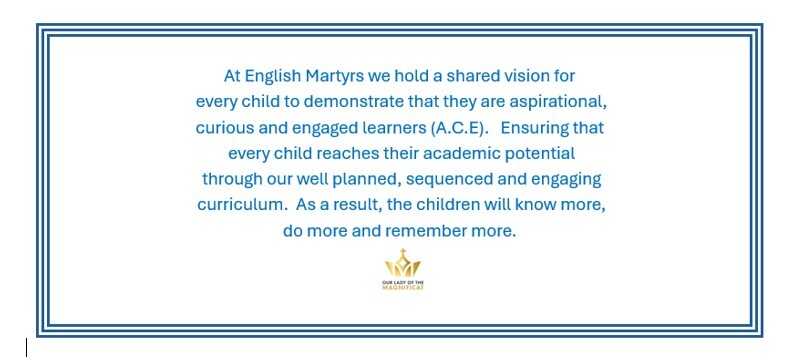- Home
- Curriculum
- Subject Information
- Computing
Computing

What does this look like in Computing?
At English Martyrs, we recognise the vital role that Computing plays in preparing children for the modern world. Our goal is to instil a love for Computing, helping students become confident and capable in a digital age. We encourage pupils to be creative, critical thinkers, and problem solvers through the exploration of technology, programming, and digital literacy.
We aim for our students to understand how technology has revolutionised daily life and its importance for future innovation and development. Our approach to teaching Computing encourages curiosity and provides the necessary skills for them to thrive as active participants in an increasingly technological world.
Curriculum Intent:
The Computing curriculum at English Martyrs follows the National Curriculum objectives and uses the Kapow Primary Computing scheme. It emphasises key areas such as digital literacy, computational thinking, and problem-solving skills. Lessons are designed to build pupils’ understanding progressively and enable them to apply this knowledge to real-world scenarios, fostering confidence in working with technology.
For the youngest learners, the curriculum covers basic skills such as understanding how to interact safely with digital devices, while older students are introduced to more complex topics like programming, algorithms, and data representation. Pupils are also taught about the importance of e-safety, ensuring they know how to use the internet responsibly.
Curriculum Implementation:
EYFS and Key Stage 1
In the early years, computing focusses on developing familiarity with technology. Pupils engage in hands-on activities that help them explore and understand simple concepts, like how to operate digital devices and use age-appropriate software to express their ideas. By the end of Key Stage 1, students will be able to create simple programs, understand basic algorithms, and use technology to collect and present information.
Key Stage 2
The computing curriculum is scaffolded to build on prior knowledge, revisiting key concepts to ensure retention and understanding. Students’ progress from creating simple programs and exploring algorithms in the lower years to working with more complex programming languages and solving real-world problems using technology in the upper years.
Key vocabulary is emphasised in each lesson, and misconceptions are addressed promptly. The curriculum also integrates practical tasks with theoretical learning, allowing students to practice digital literacy skills, such as typing and researching safely online, alongside creative tasks like coding projects or multimedia presentations.
What a typical lesson looks like:
Flashback (Recap & Recall): A review of previously learnt skills to reinforce memory retention.
Teach it: (Attention Grabber & Main Event) Introduction to new concepts with key vocabulary and addressing common misconceptions.
Practise it: Pupils engage in hands-on activities such as programming, using software, or researching online.
Prove it: Opportunities to demonstrate understanding through independent tasks or collaborative projects.
Dig Deeper: Pupils link ideas and demonstrate higher-order thinking, such as comparing different programming languages or evaluating the efficiency of algorithms.
Assessment: Assessment is continuous, involving both formative and summative methods. Teachers monitor progress through questioning, live feedback, and more formal evaluations like project assessments or quizzes. Regular data tracking ensures that all students, including those with special educational needs (SEND), are progressing towards national outcomes.
Curriculum Impact:
The computing curriculum at English Martyrs strives to foster not only technical skills but also critical thinking and problem-solving abilities. By the end of their time at the school, pupils will have developed a comprehensive understanding of how technology can be used creatively and responsibly. They will also be well-prepared to engage with future learning in computing, ensuring they have the skills required for the digital world.
Monitoring, Evaluation and Review
As with other subjects, the computing curriculum is regularly reviewed through lesson observations, pupil interviews, and data analysis. This ensures the curriculum remains dynamic and responsive to the needs of all learners, while also integrating the latest technological developments and practices​.